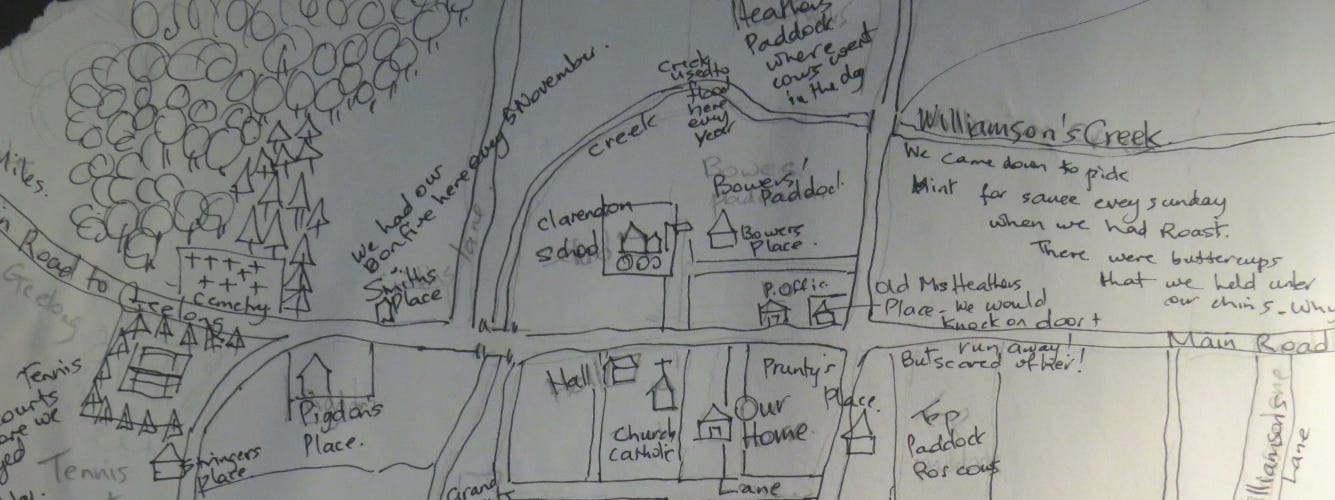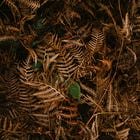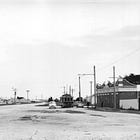A Map of Memory
My mother grew up on a small farm near Clarendon in western Victoria, Australia. They didn’t own much land, but worked a patchwork of paddocks around the village. Years ago now, she drew a map of this world from. This was the terrain of her childhood in the 1950’s: the lanes, the creek crossings, the fields where they kept their cows, sheep and planted potatoes.
Today’s poem and reflection follows her footsteps, bringing the cows in across Williamson’s Creek, through the mud, and into the hush of evening where her father waited to milk the cows with her.
Map drawn by my mother of the paddocks around Clarendon, c. 1950s.
Heathers’ Paddocks
The creek was in flood,
cows high near the fence line,
heads down—
knowing.
She is on her way
as the first stars shine,
feet cold
but clean now
from the green creek
where yellow flowers swim
beneath the surface—
flowing.
The cows walk down
at her creek-song call,
from the hollow,
thinking of the stove door
opening.
Soon she feels the steam
of their warm breath
as she touches their sides—
the gate
closing.
At the main road,
free from far-off headlights,
imagined horns
loud in the darkening.
Muddy lane beckoning,
and the milking shed
where her father hides
his last drink
smiling.
Her Voice: In Her Own Words
Below is a passage from my mother, Peggy’s, handwritten foolscap pages. In them, she described the routine of bringing the cows home for milking, through floodwater, across roads, into a yard forever muddy. These aren’t just rural chores; they’re the contours of a life lived with grit, rhythm, and quiet resilience.
“In the afternoon they were usually at Heathers’ and sometimes in winter it would be getting dark by the time we got them out of the far corners of the big paddocks. They were more often than not in the far corner. I would begin to call "Come on" as I got closer and they might begin to move on down to the gate, ready. I suppose they knew what they were doing. Heathers’ was quite often in flood and I would sometimes have to puddle or wade through the knee-high water and round the cows up. They would take off up the hill…”
“Bringing them back up the lane was a challenge. The trick was to get the stragglers to the top of the hill near Heathers’ house before the leaders got onto the main road. If they were good, they would head around the corner and down the side of the road, so we could watch for 'no cars' and get them across the road. Then we were right, just beat the leaders down to our lane corner; with any luck, they would find their way into our yard…”
“There was a house yard and a back yard, both of which seemed to be forever muddy. The cows were brought into the back yard twice a day. To get to the back gate one wallowed through the mud or went the ‘long way’ round the lane. The mud was usually halfway up your legs. We did not wear shoes very often—only school and church. The kitchen floor was forever dirty due to the mud…”
“The cows would be yarded up and I would help milk them, by hand. There were two bales. Dad would use one, I would use the other. My older sisters would help milk, but as we got older, they all went off working, I guess. After milking was finished, Dad would be left to separate the milk and feed the calves with the skim milk. We would follow the same routine in the morning…”
“If Dad did not make it home from out the paddocks, we would do all the milking. I would do it all as we got older, I remember on many occasions. You see, Dad would head off further, as the pub was just past the paddocks and Dad could not live without his drink…”
What She Carried Through to Me
There’s something deeply grounding about walking the tracks our mothers once walked. Eespecially when we do so through memory and story. In these small acts, bringing in cows, searching for hen eggs in the blackberries, chopping wood, lighting the stove in the morning. We glimpse the shape of a life not always spoken aloud. A life remembered, daydreamed, and carried within them always.
Writing this poem helped me see the landscape of my mother’s childhood not just as history, but as a kind of hidden realm. Her home world. Her barefoot path through flooded creeks and muddy yards becomes, for me, an inner map. One that leads not only to the past, but to the heart of what it means to endure, to provide, and to hold onto beauty. Even in the most challenging moments in life.











These windows into your Mother's life - and how her world once was - are very moving. The map she drew is wonderful...
Best Wishes - Dave :)
I so enjoyed this sensory walk through your mother’s imagined experiences. It’s very interesting to see her map, and her account of calling in the cows. As a woman raised in Texas, I can feel the way as well as sense the differences here.